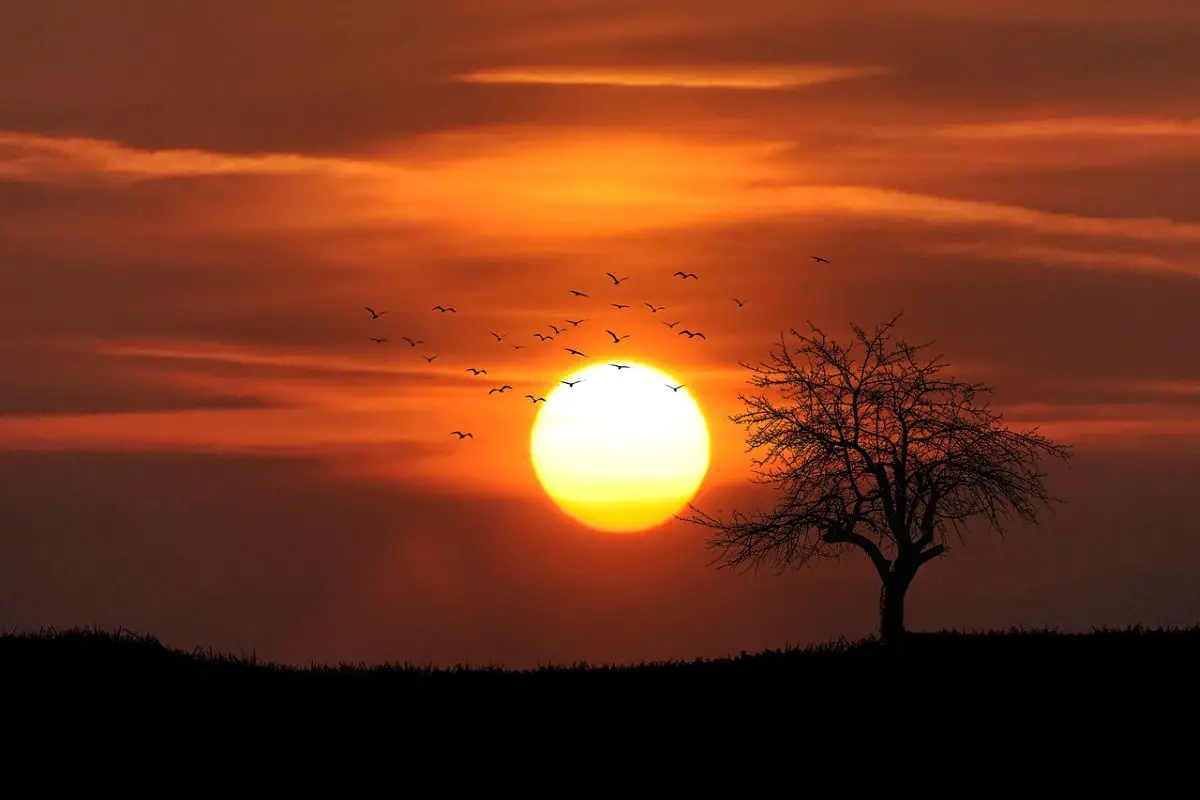Our lives revolve around the Sun. For most of us, our days start when the Sun rises and ends when it sets, and that’s about it. Not many of us may care beyond that. However, some wonder if the Sun has a direction as it moves. Which direction does the Sun rise?
Sunrise happens in the east, and sunset happens in the west. This is because the Earth rotates from the west to the east, which means the east will be the first to see the Sun on a new day. The east will also be the first to see the sunset as well. The moon also rises east and sets west, similar to the Sun.
This article explains the direction where the Sun rises and sets. We also discuss other relevant questions you may have about the Sun and moon, such as why the Sun rises and sets and if the moon moves in the same way.
We also discuss the hypothetical situation if the Sun can ever rise from the west and set in the east.
Why Does The Sun Rise And Set?
The Sun appears to rise and set due to the Earth’s rotation. The Sun illuminates part of the Earth, and as your area starts to enter the illumination, it appears as if the Sun is rising. When the Earth has rotated to the point that it is leaving the Sun’s illumination, the Sun will appear to set.
Generally, when we observe sunrise or sunset, we can see that the Sun is moving up or down.
However, the Sun does not move in such a manner, nor does the Earth. Instead, the phenomenon of sunrise and sunset appears due to the Earth’s rotation.
As the Earth rotates on its own axis from west to east, the part facing the Sun gets sunlight, which means this area is daytime. The other side facing away from the Sun does not get sunlight, which means it is nighttime in these areas.
While the Earth rotates, your location may soon rotate to the point it starts to receive sunlight. As your location transitions in, you may start to see the Sun.
As the Earth rotates, your location is also getting closer and closer to the Sun. This translates into you seeing the sun’ rising’ up.
You can also use the same understanding and logic to the sun setting. As your location starts to rotate away from the Sun, it becomes further from the Sun. As such, you may see the Sun setting away and disappear into the sea or hills.
Which Direction Does The Sun Rise?
Sunrise happens in the east, and sunset happens in the west. This is due to the rotation of the Earth. The Earth rotates from east to west. This means the east will first see daylight on any given new day. The east will also first experience sunset as well.
The Sun comes up in the east and goes down in the west. The reason for this is that the Earth spins from west to east.
Other movements are also going on, like the Earth around the Sun and everything. But for now, let us think about how the Earth turns from west to east.
The Earth rotates and moves toward the east. This explains why the Sun, Moon, planets, and stars all rise in the east. They then ‘move’ across the sky toward the west before setting and disappearing.
Let us say you are looking east. This means that as the planet turns, it moves you toward the east. This means that whatever is beyond the eastern horizon will eventually come up over the horizon and be visible to you.
In fact, the speed can be pretty amazing. We are talking about 994 miles per hour (1,600 kilometers per hour), which is faster than the speed of sound.
But you might not feel the speed because humans do not have a “speed sensor” built in. We use our eyes to judge speed by looking at how fast things move away from each other.
You may like this article: Which Planet Is Farthest From The Sun?
Why Does The Sun Rise and Set In Red Color?
The Sun rises and sets in red color because it is further away from our eyes. This means some of the blue light the Sun emits gets scattered by the atmosphere, making the Sun look redder. This phenomenon is least pronounced in the afternoon when the Sun is closest to you. There is little scattering of light, meaning the Sun appears white.
Before we talk about color, we first need to talk about sunlight. Sunlight contains a mixture of electromagnetic waves and rays. Some common electromagnetic waves we have heard include X-rays, radio waves, UV rays, or gamma rays from radioactive materials.
A small sliver of these rays is visible to our eyes as light, for example, waves emitted by our bulbs and computer screens.
The Sun emits all sorts of electromagnetic rays. Some can be seen by our eyes, some not. As a result, we may see the run in different colors throughout the day.
This happens because, during sunrise, the Sun is much further away from our position. This means the electromagnetic waves generated by the Sun need to travel longer to each of our eyes.
During the journey, some of their ‘higher’ frequency waves, such as blue light or UV light, may be scattered by the atmosphere. This means only the lower frequency waves to reach our eyes. As a result, the Sun may appear red.
This also explains the mid-day. The Sun may appear white during midday, as it is at its closest point to your location. This means many of the higher frequency wavelengths can reach our eyes, making the Sun appear white. This is if you can even look at the midday sun directly!
Which Direction Does The Moon Rise And Set?
The moon follows the trajectory of the Sun, which means it rises from the east and sets in the west. This is also because of the Earth’s rotation from west to east. The moon does not change color during rising and setting, unlike the Sun. This is because it does not emit any rays but only reflects sunlight.
In general, the moon rises from the east and sets in the west, similar to the Sun. In fact, all celestial bodies follow the same trajectory, such as all the stars we see in the sky.
This is not because of the Sun, moon, or stars, but due to the Earth itself. The Earth’s rotation from west to the east means you are constantly moving towards the west, giving you the impression that these objects rise east and set west.
Despite following the same trajectory as the Sun, the moon does not change color during its rising or setting. This is because the moon emits no rays but reflects the Sun instead.
The difference may be in that on different days of the month, you may see a part or the whole of the moon. This is due to the angle at each the moon is shined on by the Sun.
The moon is not shaded by the Earth completely during a full moon. This allows it to fully reflect the sunlight, meaning you see a full, round moon.
If you see a crescent moon, a large part of the moon is shaded by the Earth. This means only a small part of the moon gets to reflect sunlight.
You may like this article: Why Is Mars Red?
Can The Sun Rise From The West?
Scientifically, the Sun cannot rise from the west. This can only happen if the Earth rotates from east to west. However, humans throughout history have speculated about such an event. Some beliefs may relate this to things such as the apocalypse.
Astrology has confirmed that each rotates from west to east. This results in the east seeing the Sun first on any new day. If we observe this from our location, we will see that the Sun rises in the east and sets in the west.
There is little way to make the sunrise from the west unless we change the Earth’s rotation from each to the west. If humans are to be crazy enough to attempt such things, then there is a need to play with the gravitational force of the Earth and many more.
This will be going against nature and makes very little sense.
In fact, there are beliefs that if the Sun rises from the west, it means the apocalypse is near. The Muslim holy book of the Quran mentions multiple ‘signs’ indicating that the apocalypse is near. One of them is the Sun rising from the west.
 Being Human
Being Human





